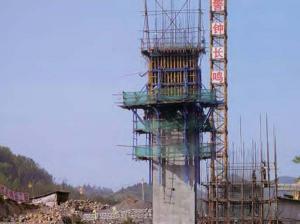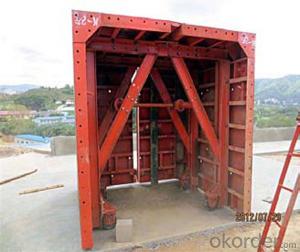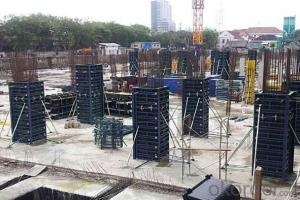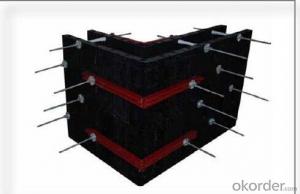Steel Formwork Scaffolding System Steel Props with high quality
- Loading Port:
- Tianjin
- Payment Terms:
- TT OR LC
- Min Order Qty:
- 27 m.t
- Supply Capability:
- 1000 m.t/month
OKorder Service Pledge
OKorder Financial Service
You Might Also Like
Steel Formwork Scaffolding System Steel Props with high quality
Product pictures:
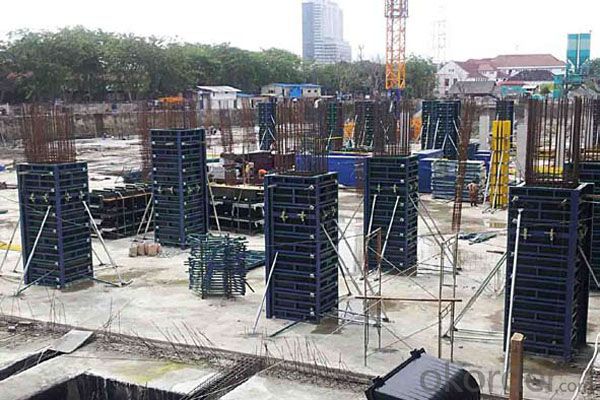
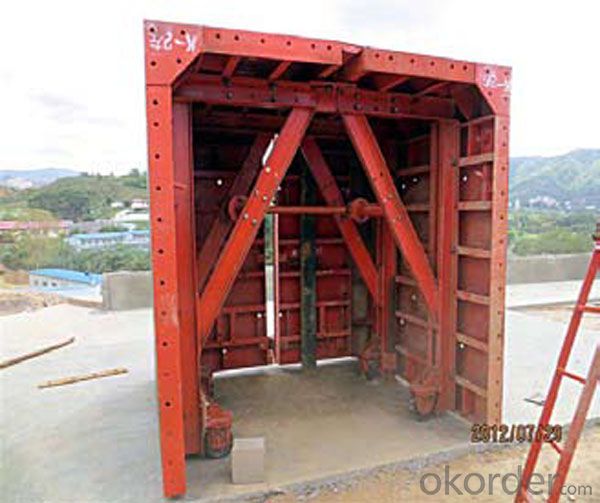
Product description:
Name: | RingLock Scaffold System |
Category: | Scaffolding System |
Material: | Steel (Q235/Q345) |
Size: | D48*3.25mm, etc |
Surface: | Electro Galvanized, Hot Dipped Galvanized, Painted, Powder Coated |
Component: | Standard, Ledger, Diagonal Brace, Bracket, Base Jack, U Head Jack, Etc. |
Application: | Slab Support, Staircase, Stage Plateforms, Bridge Support, Mobile Tower, etc. |
Manufacturer: | OEM is Available |
Items or goods can be manufactured according to your standards. | |
Advantage
* Good loading capacity
* Easy to assemble and dismantle
* Excellent quality for formwork & scaffolding with wide choices
Other scaffolding & formwork products:
(1) Scaffolding System:
(2) Scaffolding Frame & Accessories:
(3) Scaffolding Couplers/Clamps:
(4) Formwork System Scaffolding & Accessories:
Company introduce and advantages:
1. A state-owned company, prestige fi rst.
2. One of Fortune 500 companies in the world. No. 5 in the building material fi eld.
3. Six Sigma strategy , which means no more than 3.4 defects existing among one million of error
possibilities.
4. In line with the business, we launched E-business platform Okorder.com.
5. We are highly recognized by our business partners and clients all over the world and has obtained rapid
development under the spirit of win-win.
FAQ
Why Us?
We are one of the largest construction materials suppliers in China.
We own professional manufacturers with powerful producing capacity.
Extensive and comprehensive quality control system
Excellent products with competitive prices.
Efficient services in pre and after sale.
Full energy with affluent experience team.
- Q:How does steel frame formwork handle extreme weather conditions?
- Steel frame formwork is designed to be highly durable and resistant to extreme weather conditions. Its sturdy steel construction ensures that it can withstand heavy rain, high winds, and even extreme temperatures without compromising its structural integrity. Additionally, steel frame formwork is often coated with protective finishes or coatings, such as galvanization or epoxy, which further enhance its resistance to corrosion and weathering. This enables it to remain reliable and functional even in harsh weather conditions, making it an ideal choice for construction projects in areas prone to extreme weather.
- Q:How does steel frame formwork contribute to better concrete compaction?
- Steel frame formwork contributes to better concrete compaction by providing a rigid and stable structure that holds the concrete in place during the pouring and curing process. The steel frame formwork ensures that the concrete is properly contained, preventing any displacement or bulging that could occur with other types of formwork. This allows for a more even distribution of the concrete and ensures that it is compacted uniformly, resulting in a higher quality and more durable finished product.
- Q:Can steel frame formwork be used for curved or irregular shaped structures?
- Yes, steel frame formwork can be used for curved or irregular shaped structures. Steel formwork is highly versatile and can be easily adjusted and modified to accommodate different shapes and sizes. It offers great flexibility and can be curved or bent to fit the desired shape of the structure. Additionally, steel formwork is known for its strength and durability, making it suitable for complex and irregular structures. The steel frame can be customized and fabricated to match the specific requirements of the project, allowing for efficient and accurate construction of curved or irregular shaped structures.
- Q:How does steel frame formwork compare to other formwork systems in terms of cost?
- Compared to timber or aluminum formwork systems, steel frame formwork typically has a higher upfront expense due to the costlier steel material. However, when looking at the overall cost throughout a project's lifespan, steel frame formwork proves to be more economically viable. The durability and reusability of steel frame formwork are major advantages. Steel is a robust material that can endure multiple uses and rough handling at construction sites. Consequently, steel formwork can be reused numerous times, reducing the need for frequent replacements and lowering long-term expenses. In addition, steel frame formwork offers greater flexibility and adaptability in comparison to other formwork systems. It can be easily customized and adjusted to meet various project requirements, resulting in reduced labor costs and improved efficiency. The ability to reuse steel formwork also decreases material costs by reducing the need to constantly purchase new formwork for each project. Moreover, steel frame formwork provides a higher level of precision and accuracy in achieving desired shapes and dimensions. This leads to fewer errors and rework, saving both time and money during the construction process. Although the initial cost of steel frame formwork may be higher, its long-term cost-effectiveness, durability, reusability, flexibility, and precision position it as a favorable choice compared to other formwork systems. It is crucial to consider the specific requirements and budget constraints of a project when assessing the cost-effectiveness of different formwork systems.
- Q:The steel frame structure of short column reinforced head after bending and shear module and embedded parts embedded anchor bolts. How to do, can be reinforced structure elbow section
- Break off a little to let the anchor bolts, cut off the design will not be recognized after the
- Q:How does steel frame formwork handle concrete pouring in earthquake-prone areas?
- Due to its inherent strength and flexibility, steel frame formwork is a highly effective method for managing concrete pouring in earthquake-prone areas. This is because the steel frame provides a strong and sturdy structure that can endure the forces exerted during an earthquake, thus guaranteeing the safety of the concrete pour and the overall stability of the building. An important advantage of steel frame formwork is its capacity to absorb and disperse the energy produced by seismic activity. The steel frame functions as a robust and inflexible support system, evenly distributing the seismic forces throughout the structure. Consequently, this diminishes the impact on the concrete pour and reduces the risk of substantial damage. Moreover, steel frame formwork is designed to be easily adjustable and adaptable, allowing for swift modifications to the formwork system as necessary. This adaptability is crucial in earthquake-prone areas where the ground conditions and the intensity of seismic activity can vary. It guarantees that the formwork can be altered to accommodate any changes or adjustments required during and after an earthquake, without compromising the integrity of the concrete pour. Furthermore, steel frame formwork is highly durable and long-lasting, making it a perfect choice for use in seismic zones. The strength and resilience of steel enable it to withstand the repetitive loading and shaking caused by earthquakes over an extended period. This durability ensures that the steel formwork can endure multiple seismic events, providing a dependable and secure solution for concrete pouring in earthquake-prone areas. In conclusion, steel frame formwork provides a robust and flexible solution for managing concrete pouring in earthquake-prone areas. Its strength, adaptability, and durability make it an excellent choice for handling the seismic forces generated during earthquakes, thus ensuring the safety and stability of the concrete pour and the overall structure.
- Q:What are the different types of bracing systems used with steel frame formwork?
- There are several different types of bracing systems that can be used with steel frame formwork. These systems are designed to provide stability and support to the formwork during the concrete pouring process. Some of the common types of bracing systems used with steel frame formwork include: 1. Horizontal bracing: This type of bracing is used to provide lateral stability to the formwork. It is typically installed at regular intervals along the horizontal beams of the formwork system. Horizontal bracing helps to prevent the formwork from buckling or collapsing under the weight of the concrete. 2. Vertical bracing: Vertical bracing is used to provide vertical support to the formwork. It is typically installed at regular intervals along the vertical columns of the formwork system. Vertical bracing helps to prevent the formwork from sagging or bending under the weight of the concrete. 3. Diagonal bracing: Diagonal bracing is used to provide both lateral and vertical support to the formwork. It is typically installed in a diagonal pattern between the horizontal and vertical bracing elements. Diagonal bracing helps to distribute the load more evenly across the formwork and increase its overall stability. 4. Cross bracing: Cross bracing is a type of bracing that is used to provide additional stability to the formwork. It involves installing diagonal braces that intersect each other in an "X" shape. Cross bracing helps to prevent the formwork from twisting or rotating during the concrete pouring process. 5. Tension rods: Tension rods are another type of bracing system that can be used with steel frame formwork. They are typically installed vertically and horizontally along the formwork system and are tightened to provide additional support. Tension rods help to enhance the overall strength and stability of the formwork. Overall, the selection of the bracing system will depend on factors such as the height and size of the formwork, the load it will be subjected to, and the specific requirements of the construction project. It is important to choose a bracing system that is appropriate for the specific application and meets the necessary safety standards.
- Q:What are the different types of safety nets and fall protection systems used with steel frame formwork?
- There are several types of safety nets and fall protection systems that are commonly used with steel frame formwork to ensure the safety of workers. These systems are designed to prevent falls from heights and provide a secure working environment. One of the most common safety nets used with steel frame formwork is the perimeter safety net. This net is installed around the perimeter of the work area to catch falling objects and prevent them from reaching the ground or the workers below. It is typically made of high-strength nylon or polypropylene and is designed to withstand heavy impacts. Perimeter safety nets are essential in preventing accidents and injuries caused by falling debris. Another type of fall protection system used with steel frame formwork is the safety harness and lanyard system. This system consists of a full-body harness that is worn by the worker and is connected to an anchorage point using a lanyard. The harness distributes the force of a fall across the worker's body, reducing the risk of injury. The lanyard is typically made of a high-strength material such as nylon or polyester and is designed to absorb the energy of a fall. In addition to safety nets and harness systems, guardrails are also commonly used with steel frame formwork. Guardrails are barriers that are installed around the perimeter of the work area to prevent workers from accidentally falling off the edge. They are typically made of high-strength steel or aluminum and are designed to withstand heavy impacts. Guardrails provide a physical barrier that serves as a constant reminder to workers about the potential danger of working at heights. Lastly, safety platforms are often used with steel frame formwork to provide a stable and secure working surface for workers. These platforms are typically made of steel or aluminum and are designed to be easily installed and removed. Safety platforms provide a flat surface for workers to stand on while working at heights, reducing the risk of slips and falls. In conclusion, the different types of safety nets and fall protection systems used with steel frame formwork include perimeter safety nets, safety harness and lanyard systems, guardrails, and safety platforms. These systems are essential in preventing falls from heights and ensuring the safety of workers in construction sites.
- Q:Can steel frame formwork be used for retrofitting or renovation projects?
- Yes, steel frame formwork can be used for retrofitting or renovation projects. Steel frame formwork is a versatile and durable system that is commonly used in construction projects, including retrofitting and renovation projects. It is designed to provide support and structure to concrete during the pouring and curing process. In retrofitting or renovation projects, steel frame formwork can be used to create new concrete structures or to repair and strengthen existing structures. It can be used to create new walls, beams, columns, or slabs, or to reinforce existing ones. The advantage of using steel frame formwork in retrofitting projects is that it provides a strong and stable support system, ensuring that the concrete is poured and cured correctly. It can also be easily adjusted and repositioned as needed, allowing for flexibility in design and construction. Additionally, steel frame formwork is reusable, which makes it cost-effective and environmentally friendly. It can be easily dismantled and reused in multiple projects, reducing waste and saving resources. Overall, steel frame formwork is a suitable and efficient solution for retrofitting or renovation projects, providing the necessary support and structure for concrete elements while offering flexibility, durability, and cost-effectiveness.
- Q:What are the different types of lifting inserts used with steel frame formwork?
- There are several types of lifting inserts that can be used with steel frame formwork. These inserts are designed to provide a secure and efficient method of lifting and moving the formwork. One type of lifting insert is the threaded lifting insert. This type of insert features a threaded rod that is embedded into the formwork. A lifting eye or hook can then be attached to the threaded rod, allowing for easy lifting and moving of the formwork. Another type of lifting insert is the recessed lifting insert. This type of insert is embedded into the formwork and features a recessed area where a lifting eye or hook can be attached. The recessed design helps to protect the lifting insert from damage during use. Additionally, there are magnetic lifting inserts that utilize powerful magnets to hold the formwork in place during lifting and moving. These inserts can be easily attached and detached from the formwork, making them convenient and efficient to use. Some lifting inserts also feature a swivel design, allowing for 360-degree rotation of the formwork during lifting and moving. This swivel capability helps to ensure that the formwork can be positioned accurately and securely. Overall, the different types of lifting inserts used with steel frame formwork provide various options for safely and effectively lifting and moving the formwork. The choice of which type to use will depend on factors such as the specific requirements of the project, the weight of the formwork, and the desired level of convenience and efficiency.
1. Manufacturer Overview |
|
|---|---|
| Location | |
| Year Established | |
| Annual Output Value | |
| Main Markets | |
| Company Certifications | |
2. Manufacturer Certificates |
|
|---|---|
| a) Certification Name | |
| Range | |
| Reference | |
| Validity Period | |
3. Manufacturer Capability |
|
|---|---|
| a)Trade Capacity | |
| Nearest Port | |
| Export Percentage | |
| No.of Employees in Trade Department | |
| Language Spoken: | |
| b)Factory Information | |
| Factory Size: | |
| No. of Production Lines | |
| Contract Manufacturing | |
| Product Price Range | |
Send your message to us
Steel Formwork Scaffolding System Steel Props with high quality
- Loading Port:
- Tianjin
- Payment Terms:
- TT OR LC
- Min Order Qty:
- 27 m.t
- Supply Capability:
- 1000 m.t/month
OKorder Service Pledge
OKorder Financial Service
Similar products
New products
Hot products
Related keywords
